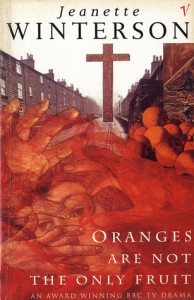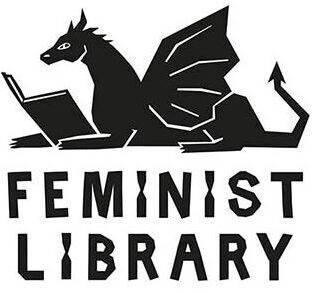Compulsory Heterosexuality in Oranges Are Not the Only Fruit
 Oranges Are Not The Only Fruit by Jeanette Winterson. Pandora Press, 1985.
Oranges Are Not The Only Fruit by Jeanette Winterson. Pandora Press, 1985.
When reading Oranges Are Not The Only Fruit you’d be forgiven for imagining the novel was taking place in some distant time and place and certainly not in twentieth century England. The semi-autobiographical novel was penned by Jeanette Winterson and published in 1985; almost instantaneously it became a classic within both the feminist and LGBT+ movements. The narrative begins as the child Jeanette is adopted into a strict English Pentecostal family by a religious couple who desire to have a child without having sexual intercourse.
Jeanette’s mother envisions that her daughter will grow up to be a missionary for the church, saving the morally damned; as such, Jeanette grows up at the heart of her religious community. Until she is 7 years old she is home schooled with the Bible as her main text. Her world exists exclusively within the walls of the church, and as a result it is through the congregation’s eyes that she learns about the world. This is a coming of age story of how she reconciles her genuine and personal religious beliefs and her desire to exist within her church with the romantic love that she feels for other women within the congregation.
Winterson emphasises, however, that this is not a novel explicitly about homosexuality but about its other themes; religion, first love, domineering mothers, but most importantly to me, the freedom of the woman. Read alongside classic feminist texts such as Judith Butler’s Gender Trouble or Monique Wittig’s The Straight Mind, this novel can be read as an exploration of the imprisonment of compulsory heterosexuality. This is the idea that in order for a patriarchal society to thrive, heterosexuality must be the default. As a result, we are pushed images of heterosexuality as the only norm, therefore implying that homosexuals are degenerate.
As we see Jeanette grow, her narrative is paralleled by fairy-tale intersects; these segments serve to interpret Jeanette’s world through a childhood frame. Dually, this draws attention to the ways in which young children, and especially girls, learn of the world around them. This critique of the narrative we portray to children is exposed most frankly through Jeanette’s interpretation of Beauty and the Beast. She says that the “beautiful young woman” is unwittingly tricked into marriage by her father, forced to “marry an ugly beast, or dishonour her family forever”. Later, she “gives it [being the beast] a little kiss” and he transforms into a “handsome young price, and they both live happily ever after”.
This interpretation of the well-known story of Beauty and the Beast emphasises the feminist ideals of the text as it criticises the apparent coercion of women into suppressive roles – the young girl is told that she must conform to heteronormativity or dishonour her family, and that she will ultimately be rewarded for this. This relation structure, however, does not simply limit us based on sexuality but also on gender roles, as the woman is allocated to the domestic, caring and nurturing role, putting her family and the happiness of the Beast before her own desires.
The idea and practice of compulsory heterosexuality generate a society in which homosexuals are either forced to conform to heteronormative practices or live on the margins. This is very clearly presented throughout Winterson’s novel. In her early childhood Jeanette is unwittingly exposed to loving same-sex relationships, however, it is never said aloud that that is indeed what they are. This forced silence is prevalent throughout the work and is a key patriarchal tool for heteronormative compliance. Those in Jeanette’s life, however, go further than this, and at one point perform exorcisms on Jeanette to attempt to rid her of her sinful ways.
In her work The Straight Mind, Monique Wittig states “these discourses of heterosexuality oppress us in the sense that they prevent us from speaking unless we speak in their terms”. This is certainly true for Jeanette, who fights to be heard against a system which rejects her – she fights and questions why it would be wrong to love another regardless of gender, but is silenced throughout. Later in her life she will be given a choice – give up her ‘gender confusion’ (the only reason her congregation believes she could love another woman) or leave forever. This is a story about one woman’s struggle to fight for her freedom, wrestling between two extremely unappealing choices. An incredibly emotive, character-driven read, Winterson’s novel explores the many romantic restrictions that women have faced, and that many still face today.
Review by Harriet Elizabeth.
The concept of compulsory heterosexuality was first laid out in an important pamphlet which is also part of our collection: Compulsory Heterosexuality and Lesbian Existence by Adrienne Rich, Only Women Press, 1981.
